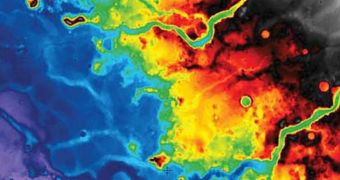According to the People's Daily newspaper, it would appear that the China National Space Administration (CNSA) wants to launch its first Mars-bound spacecraft in October 2011, in cooperation with the Russian Federation.
If the plan materializes, it will be the first orbiter that China sends to the Red Planet. Additionally, it would also represent the crowning of long-term plans concocted with Russia.
Originally, this cooperative mission was supposed to launch in October 2009, together with the Russian-built Phobos Explorer spacecraft. The two were supposed to take off from the Baikonur Cosmodrome, in Kazakhstan.
But the launch of the Chinese Yinghuo-1 space probe was delayed by two years, to October of this year. It would now appear that everything is set for the much-anticipated launch, the newspaper reports.
The main mission that the the probe has is to survey the surface of our neighboring planet, and determine whether it hosted huge lakes and oceans in the past or not, Daily Galaxy reports.
Over the past few years, ample evidence have been gathered to support the wet Mars hypothesis. The idea claims that our neighboring planet was covered in rivers, lakes, and deltas a few billion years ago, and that its northern hemisphere even featured a liquid ocean.
Even though the instruments on Yinghuo-1 are more than enough to test this idea, China also plans to launch an entirely stand-alone spacecraft to Mars in 2013.
The Chinese effort will join the international initiative of mapping the entire surface of Mars in 3D. This will allow experts to better understand the history of the Red Planet.
Professor Jan-Peter Muller, who holds an appointment with the Mullard Space Science Laboratory at the University College London (UCL) Department of Space Climate Physics, is already involved in the 3D modeling effort.
“We can now model the 3D shape of Mars' surface down to sub-meter resolution, at least as good as any commercial satellite orbiting the Earth. This allows us to test our hypotheses in a much more rigorous manner than ever before,” he explains.
Data from the Chinese missions will be combined with readings of the Martian surface collected by NASA spacecrafts such as the MRO, Mars Odyssey, MGS, and the European Space Agency's (ESA) Mars Express.

 14 DAY TRIAL //
14 DAY TRIAL //